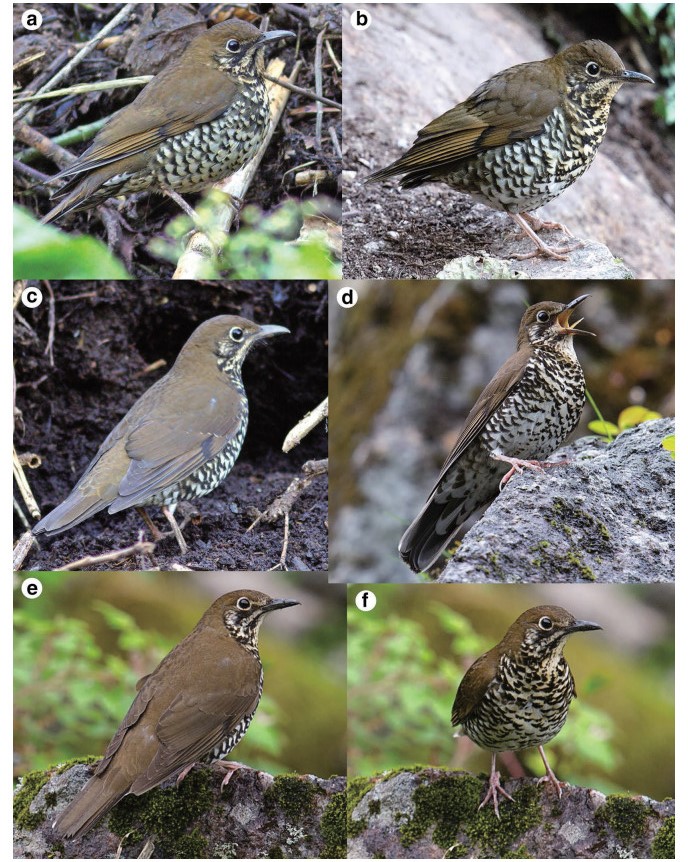
Himalayan Forest Thrush Z. salimalii, sp. nov., Darjeeling District, West Bengal, India (Subrato Sanyal) (a); Baihualing, Yunnan, China, early February (Craig Brelsford; same individual as in Fig. 4, but other side of head; the tail has apparently been accidentally lost and is growing) (b); Darjeeling District, West Bengal, India (Subrato Sanyal; different individual from a) (c); Dulongjiang, Yunnan, mid June (Craig Brelsford; same individual) (d-f)
Figures of the Article
-
![]() Distributions of identified records of taxa (as defined herein) of the Z. mollissima complex (Z. dixoni not shown), based on verified specimens, photographs, sound recordings and genetic samples. a Alpine Thrush Z. mollissima sensu stricto (including whiteheadi, synonymized herein) and localities for verified genetic samples of "Yunnan Thrush" Z. mollissima(?). b Himalayan Forest Thrush Z. salimalii sp. nov. and Sichuan Forest Thrush Z. griseiceps. Filled black symbols represent records from June to August, filled grey from April to May and September to October and open
symbols from November to March. Multiple site records are not indicated; where multiple records exist from different seasons, site seasonality codes mapped are those during or closest to the breeding season. Labelled provinces and states are those referred to prominently in the text in reference to particular records and/or taxa. The Manipur specimen localities for the Himalayan Forest Thrush could not be traced, so the symbol is arbitrarily located in the center of the western Manipur hill range
Distributions of identified records of taxa (as defined herein) of the Z. mollissima complex (Z. dixoni not shown), based on verified specimens, photographs, sound recordings and genetic samples. a Alpine Thrush Z. mollissima sensu stricto (including whiteheadi, synonymized herein) and localities for verified genetic samples of "Yunnan Thrush" Z. mollissima(?). b Himalayan Forest Thrush Z. salimalii sp. nov. and Sichuan Forest Thrush Z. griseiceps. Filled black symbols represent records from June to August, filled grey from April to May and September to October and open
symbols from November to March. Multiple site records are not indicated; where multiple records exist from different seasons, site seasonality codes mapped are those during or closest to the breeding season. Labelled provinces and states are those referred to prominently in the text in reference to particular records and/or taxa. The Manipur specimen localities for the Himalayan Forest Thrush could not be traced, so the symbol is arbitrarily located in the center of the western Manipur hill range
-
![]() PCAs of three external measurements (two different sets used to allow inclusion of all holotypes) of skin specimens of taxa of the Z. mollissima-Z. dixoni complex, showing position of holotypes (identified by first letter of species name; see key to types; symbols as for their respective taxon but filled grey); and sequenced specimens (numbered as in Additional File 1: Table S1; symbols as for their respective taxon but larger and black with white lettering). a Analysis using bill width, wing, and tarsus. b Analysis using wing, tail, and tarsus, including Blyth's measurements of the female holotype of T.
mollissimus Blyth, 1842 (symbol m). c PCA of external measurements of skin specimens (males only) of taxa of the Z. mollissima-Z. dixoni complex, showing position of male holotypes. For summary statistics, see Table 2
PCAs of three external measurements (two different sets used to allow inclusion of all holotypes) of skin specimens of taxa of the Z. mollissima-Z. dixoni complex, showing position of holotypes (identified by first letter of species name; see key to types; symbols as for their respective taxon but filled grey); and sequenced specimens (numbered as in Additional File 1: Table S1; symbols as for their respective taxon but larger and black with white lettering). a Analysis using bill width, wing, and tarsus. b Analysis using wing, tail, and tarsus, including Blyth's measurements of the female holotype of T.
mollissimus Blyth, 1842 (symbol m). c PCA of external measurements of skin specimens (males only) of taxa of the Z. mollissima-Z. dixoni complex, showing position of male holotypes. For summary statistics, see Table 2
-
![]() PCA of plumage scoring of skin specimens of taxa of the Z. mollissima-Z. dixoni complex, showing position of holotypes and sequenced specimens. Symbols as in Fig. 2
PCA of plumage scoring of skin specimens of taxa of the Z. mollissima-Z. dixoni complex, showing position of holotypes and sequenced specimens. Symbols as in Fig. 2
-
![]() Heads of Alpine Thrush Z. mollissima sensu stricto (top; Bhutan, late April, Yann Muzika), Himalayan Forest Thrush Z. salimalii, sp. nov. (middle; Baihualing, Yunnan, China, early February, Craig Brelsford) and Sichuan Forest Thrush Z. griseiceps (bottom; Chengdu, Sichuan, China, mid April, Xianwei Yang). Note differences in pattern of lores (least patterned in Alpine, most in Himalayan Forest); subocular/moustachial area (darkest in Himalayan Forest); auriculars (usually extensively pale-mottled throughout, with dark patch at rear in Alpine; variously pale-mottled in Himalayan Forest, mainly in lower rear corner, with indistinct or no dark patch at rear; usually rather uniformly, thinly pale-streaked in Sichuan Forest); colour contrast (Sichuan Forest) or lack of colour contrast (two others) between top of head and mantle; and colour of base of lower mandible (usually pale in Alpine, dark in others). Bill proportionately largest in Himalayan Forest and smallest in Alpine Thrush, but this Himalayan Forest has unusually small bill
Heads of Alpine Thrush Z. mollissima sensu stricto (top; Bhutan, late April, Yann Muzika), Himalayan Forest Thrush Z. salimalii, sp. nov. (middle; Baihualing, Yunnan, China, early February, Craig Brelsford) and Sichuan Forest Thrush Z. griseiceps (bottom; Chengdu, Sichuan, China, mid April, Xianwei Yang). Note differences in pattern of lores (least patterned in Alpine, most in Himalayan Forest); subocular/moustachial area (darkest in Himalayan Forest); auriculars (usually extensively pale-mottled throughout, with dark patch at rear in Alpine; variously pale-mottled in Himalayan Forest, mainly in lower rear corner, with indistinct or no dark patch at rear; usually rather uniformly, thinly pale-streaked in Sichuan Forest); colour contrast (Sichuan Forest) or lack of colour contrast (two others) between top of head and mantle; and colour of base of lower mandible (usually pale in Alpine, dark in others). Bill proportionately largest in Himalayan Forest and smallest in Alpine Thrush, but this Himalayan Forest has unusually small bill
-
![]() Alpine Thrush Z. mollissima sensu stricto, Niubei Shan, Sichuan, China, mid June (Chao Zhao; same individual as in Figs. 6, 9, IOZ 20890 and probably also AV19499) (a, e, i, l); Himalayan Forest Thrush Z. salimalii, sp. nov., Dulongjiang, Yunnan, China, mid June (Per Alström; same individual as in Fig. 10, IOZ 19659 and AV19235) (b, f, j, m); Dulongjiang, Yunnan, China, mid June (Per Alström; same individual as in Fig. 10, IOZ 19658 and AV19240) (d, g); Sichuan Forest Thrush Z. griseiceps, Jiuding Shan, Sichuan, China, mid May (Per Alström; same individual as in Fig. 12, IOZ 20222 and AV19505) (c, h, k); Vietnam, 24 December 1929, holotype in BMNH (Per Alström) (n)
Alpine Thrush Z. mollissima sensu stricto, Niubei Shan, Sichuan, China, mid June (Chao Zhao; same individual as in Figs. 6, 9, IOZ 20890 and probably also AV19499) (a, e, i, l); Himalayan Forest Thrush Z. salimalii, sp. nov., Dulongjiang, Yunnan, China, mid June (Per Alström; same individual as in Fig. 10, IOZ 19659 and AV19235) (b, f, j, m); Dulongjiang, Yunnan, China, mid June (Per Alström; same individual as in Fig. 10, IOZ 19658 and AV19240) (d, g); Sichuan Forest Thrush Z. griseiceps, Jiuding Shan, Sichuan, China, mid May (Per Alström; same individual as in Fig. 12, IOZ 20222 and AV19505) (c, h, k); Vietnam, 24 December 1929, holotype in BMNH (Per Alström) (n)
-
![]() Alpine Thrush Z. mollissima sensu stricto. Eaglenest, eastern Himalayas, early February (Yann Muzika) (a); Eaglenest, late January (Vijay Cavale) (b); Kedarnath, Uttarakhand, India, mid June (Sachin Rai; same individual as in Fig. 9 and AV19225) (c); Niubei Shan, Sichuan, China, mid June (Chao Zhao; same individual as in Figs. 5, 9, IOZ 20890 and AV19499) (d); Kangding, Sichuan, China, early April (Huaming Zhou) (e); Dali, Yunnan, China, early March (John and Jemi Holmes) (f); Eaglenest, early March (Adesh Shivkar) (g). Note that as no DNA data are available for e and f, one or both could theoretically represent the "Yunnan Thrush", which is only known from Yunnan, and which is not known to differ in plumage from Alpine Thrush
Alpine Thrush Z. mollissima sensu stricto. Eaglenest, eastern Himalayas, early February (Yann Muzika) (a); Eaglenest, late January (Vijay Cavale) (b); Kedarnath, Uttarakhand, India, mid June (Sachin Rai; same individual as in Fig. 9 and AV19225) (c); Niubei Shan, Sichuan, China, mid June (Chao Zhao; same individual as in Figs. 5, 9, IOZ 20890 and AV19499) (d); Kangding, Sichuan, China, early April (Huaming Zhou) (e); Dali, Yunnan, China, early March (John and Jemi Holmes) (f); Eaglenest, early March (Adesh Shivkar) (g). Note that as no DNA data are available for e and f, one or both could theoretically represent the "Yunnan Thrush", which is only known from Yunnan, and which is not known to differ in plumage from Alpine Thrush
-
![]() Himalayan Forest Thrush Z. salimalii, sp. nov., Darjeeling District, West Bengal, India (Subrato Sanyal) (a); Baihualing, Yunnan, China, early February (Craig Brelsford; same individual as in Fig. 4, but other side of head; the tail has apparently been accidentally lost and is growing) (b); Darjeeling District, West Bengal, India (Subrato Sanyal; different individual from a) (c); Dulongjiang, Yunnan, mid June (Craig Brelsford; same individual) (d-f)
Himalayan Forest Thrush Z. salimalii, sp. nov., Darjeeling District, West Bengal, India (Subrato Sanyal) (a); Baihualing, Yunnan, China, early February (Craig Brelsford; same individual as in Fig. 4, but other side of head; the tail has apparently been accidentally lost and is growing) (b); Darjeeling District, West Bengal, India (Subrato Sanyal; different individual from a) (c); Dulongjiang, Yunnan, mid June (Craig Brelsford; same individual) (d-f)
-
![]() Sichuan Forest Thrush Z. griseiceps, Chengdu, Sichuan, China, mid April (Xianwei Yang, same individual as in Fig. 4, but other side of head) (a); Chengdu, Sichuan, China, late April (Yu Yang) (b); Emei Shan, Sichuan, China, April (John and Jemi Holmes) (c); Wolong, Sichuan, late June (Per Alström; same individual as AV19505) (d); Long-tailed Thrush Z. dixoni, Yunnan, China, early April (John and Jemi Holmes) (e); Baihualing, Yunnan, China, early February (Craig Brelsford) (f)
Sichuan Forest Thrush Z. griseiceps, Chengdu, Sichuan, China, mid April (Xianwei Yang, same individual as in Fig. 4, but other side of head) (a); Chengdu, Sichuan, China, late April (Yu Yang) (b); Emei Shan, Sichuan, China, April (John and Jemi Holmes) (c); Wolong, Sichuan, late June (Per Alström; same individual as AV19505) (d); Long-tailed Thrush Z. dixoni, Yunnan, China, early April (John and Jemi Holmes) (e); Baihualing, Yunnan, China, early February (Craig Brelsford) (f)
-
![]() Sonograms of Alpine Thrush Z. mollissima sensu stricto, at Kedarnath, Uttarakhand, India, ca. 4000 m a.s.l., mid June 2009 (Shashank Dalvi; same individual as in Fig. 6c; AV19225); Sela, eastern Himalayas (two individuals), 4285 and 4200 m a.s.l., respectively, 8 and 10 June 2009 (AV19226, 19228) (Per Alström); and Niubei Shan, Sichuan, China, 3600 m, 13 June 2015 (Chao Zhao; probably same individual as in Figs. 5, 6d, IOZ 20890; AV19499). Pauses between strophes have been artificially shortened (indicated by dots)
Sonograms of Alpine Thrush Z. mollissima sensu stricto, at Kedarnath, Uttarakhand, India, ca. 4000 m a.s.l., mid June 2009 (Shashank Dalvi; same individual as in Fig. 6c; AV19225); Sela, eastern Himalayas (two individuals), 4285 and 4200 m a.s.l., respectively, 8 and 10 June 2009 (AV19226, 19228) (Per Alström); and Niubei Shan, Sichuan, China, 3600 m, 13 June 2015 (Chao Zhao; probably same individual as in Figs. 5, 6d, IOZ 20890; AV19499). Pauses between strophes have been artificially shortened (indicated by dots)
-
![]() Sonograms of possible "Yunnan Thrush", Meilixue Shan, Yunnan Province, China, 4600 m a.s.l., early June 2014 (two individuals, only observed in the field and their identification was therefore not confirmed by molecular markers) (AV19500, 19501); Long-tailed Thrush Z. dixoni, Jiuding Shan, Sichuan, China, 3500 m a.s.l., mid May 2013 (AV19502), and Manali, Himachal Pradesh, India, c. 3300 m a.s.l., late May 1999 (AV19243); and Himalayan Forest Thrush Z. salimalii sp. nov., at Dulongjiang, Yunnan Province, China, mid June 2014 (no. 1 same as in Fig. 5b, f, j, m; IOZ 19659; AV19235; 3500 m a.s.l.; and no. 2 same as in Fig. 5d, g; IOZ 19658; AV19240; 3350 m a.s.l.). Pauses between strophes have been artificially shortened (indicated by dots). All recordings by Per Alström
Sonograms of possible "Yunnan Thrush", Meilixue Shan, Yunnan Province, China, 4600 m a.s.l., early June 2014 (two individuals, only observed in the field and their identification was therefore not confirmed by molecular markers) (AV19500, 19501); Long-tailed Thrush Z. dixoni, Jiuding Shan, Sichuan, China, 3500 m a.s.l., mid May 2013 (AV19502), and Manali, Himachal Pradesh, India, c. 3300 m a.s.l., late May 1999 (AV19243); and Himalayan Forest Thrush Z. salimalii sp. nov., at Dulongjiang, Yunnan Province, China, mid June 2014 (no. 1 same as in Fig. 5b, f, j, m; IOZ 19659; AV19235; 3500 m a.s.l.; and no. 2 same as in Fig. 5d, g; IOZ 19658; AV19240; 3350 m a.s.l.). Pauses between strophes have been artificially shortened (indicated by dots). All recordings by Per Alström
-
![]() Sonograms of Himalayan Forest Thrush Z. salimalii sp. nov., at Jang, estern Himalayas, 3790 m a.s.l., 9 June 2009 (AV19230); Mandala, estern Himalayas, 3475 m a.s.l., 11 June 2009 (AV19231); Yotong La, central Bhutan, 3390 m a.s.l., late April 2003 (AV19506); Sandakphu, West Bengal, India, ca. 3600 m a.s.l., late May 1997 (AV19232). Pauses between strophes have been artificially shortened (indicated by dots). All recordings by Per Alström, except the one from Bhutan, made by Paul Ⅰ. Holt
Sonograms of Himalayan Forest Thrush Z. salimalii sp. nov., at Jang, estern Himalayas, 3790 m a.s.l., 9 June 2009 (AV19230); Mandala, estern Himalayas, 3475 m a.s.l., 11 June 2009 (AV19231); Yotong La, central Bhutan, 3390 m a.s.l., late April 2003 (AV19506); Sandakphu, West Bengal, India, ca. 3600 m a.s.l., late May 1997 (AV19232). Pauses between strophes have been artificially shortened (indicated by dots). All recordings by Per Alström, except the one from Bhutan, made by Paul Ⅰ. Holt
-
![]() Sonograms of Sichuan Forest Thrush Z. griseiceps, in Sichuan, China, at Emei Shan, mid May 1989 (AV19503); Jiuding Shan, mid May 2013 (AV19505); and Longcangguo, late May 2013 (AV19504). Pauses between strophes have been artificially shortened (indicated by dots). All recordings by Per Alström
Sonograms of Sichuan Forest Thrush Z. griseiceps, in Sichuan, China, at Emei Shan, mid May 1989 (AV19503); Jiuding Shan, mid May 2013 (AV19505); and Longcangguo, late May 2013 (AV19504). Pauses between strophes have been artificially shortened (indicated by dots). All recordings by Per Alström
-
![]() Scatter plot of principal component analysis of four song variables (duration, top frequency, bottom frequency, frequency bandwidth and peak frequency of strophes) of the Z. mollissima-Z. dixoni complex. The birds labelled 'Alpine Thrush/"Yunnan Thrush" Z. mollissima (?) Yun' were only observed in the field and their identification was therefore not confirmed by molecular markers
Scatter plot of principal component analysis of four song variables (duration, top frequency, bottom frequency, frequency bandwidth and peak frequency of strophes) of the Z. mollissima-Z. dixoni complex. The birds labelled 'Alpine Thrush/"Yunnan Thrush" Z. mollissima (?) Yun' were only observed in the field and their identification was therefore not confirmed by molecular markers
-
![]() Relationships within the Z. mollissima-Z. dixoni complex, with Z. aurea and Z. andromedae used as outgroups, based on BEAST analysis of the mitochondrial cytochrome b under a strict molecular clock with rate 2.1 %/my. Inset *BEAST analysis of the subset of the samples with the most complete sequence data (cytb, ND2, myo, ODC), with divergence rate of cytb as in the other tree and rates of other loci estimated. Posterior probabilities (PP) are indicated at the main nodes; asterisk indicates PP 1.00. Holotypes or, for Z. mollissima whiteheadi, specimens from type series in bold. Locality names of samples collected during breeding season on confirmed or probable breeding sites in italics. 1Sample originally misidentified as Z. dixoni (Klicka et al. 2005)
Relationships within the Z. mollissima-Z. dixoni complex, with Z. aurea and Z. andromedae used as outgroups, based on BEAST analysis of the mitochondrial cytochrome b under a strict molecular clock with rate 2.1 %/my. Inset *BEAST analysis of the subset of the samples with the most complete sequence data (cytb, ND2, myo, ODC), with divergence rate of cytb as in the other tree and rates of other loci estimated. Posterior probabilities (PP) are indicated at the main nodes; asterisk indicates PP 1.00. Holotypes or, for Z. mollissima whiteheadi, specimens from type series in bold. Locality names of samples collected during breeding season on confirmed or probable breeding sites in italics. 1Sample originally misidentified as Z. dixoni (Klicka et al. 2005)
-
![]() Habitats of the taxa in the Z. mollissima complex. a Alpine Thrush Z. mollissima sensu stricto, Sela, eastern Himalayas, 4200 m a.s.l., early June 2009; b Alpine Thrush, Niubei Shan, Sichuan Province, China, 3700 m a.s.l., mid-June 2015; c Alpine Thrush/"Yunnan Thrush", Meilixue Shan, Yunnan Province, China, 4600 m a.s.l., early June 2014; d Alpine Thrush/"Yunnan Thrush" (on mostly bare rocks in distance) and Himalayan Forest Thrush Z. salimalii sp. nov. (in bamboo and scrub), Dulongjiang, Yunnan Province, China, 3500 m, mid-June 2014; e Himalayan Forest Thrush, Sela pass, eastern Himalayas, 3800 m a.s.l., early June 2009; f Sichuan Forest Thrush Z. griseiceps, Jiuding Shan, Sichuan Province, China, 2700 m a.s.l., mid-May 2013; g Sichuan Forest Thrush, Wolong, Sichuan Province, China, 2975 m a.s.l., late June 2015. All photos by Per Alström
Habitats of the taxa in the Z. mollissima complex. a Alpine Thrush Z. mollissima sensu stricto, Sela, eastern Himalayas, 4200 m a.s.l., early June 2009; b Alpine Thrush, Niubei Shan, Sichuan Province, China, 3700 m a.s.l., mid-June 2015; c Alpine Thrush/"Yunnan Thrush", Meilixue Shan, Yunnan Province, China, 4600 m a.s.l., early June 2014; d Alpine Thrush/"Yunnan Thrush" (on mostly bare rocks in distance) and Himalayan Forest Thrush Z. salimalii sp. nov. (in bamboo and scrub), Dulongjiang, Yunnan Province, China, 3500 m, mid-June 2014; e Himalayan Forest Thrush, Sela pass, eastern Himalayas, 3800 m a.s.l., early June 2009; f Sichuan Forest Thrush Z. griseiceps, Jiuding Shan, Sichuan Province, China, 2700 m a.s.l., mid-May 2013; g Sichuan Forest Thrush, Wolong, Sichuan Province, China, 2975 m a.s.l., late June 2015. All photos by Per Alström
Related articles
-
2025, 16(1): 100279. DOI: 10.1016/j.avrs.2025.100279
-
2023, 14(1): 100141. DOI: 10.1016/j.avrs.2023.100141
-
2023, 14(1): 100079. DOI: 10.1016/j.avrs.2023.100079
-
2022, 13(1): 100043. DOI: 10.1016/j.avrs.2022.100043
-
2022, 13(1): 100039. DOI: 10.1016/j.avrs.2022.100039
-
2021, 12(1): 53. DOI: 10.1186/s40657-021-00289-y
-
2018, 9(1): 47. DOI: 10.1186/s40657-018-0139-0
-
2018, 9(1): 28. DOI: 10.1186/s40657-018-0121-x
-
2015, 6(1): 25. DOI: 10.1186/s40657-015-0035-9
-
2013, 4(2): 155-160. DOI: 10.5122/cbirds.2013.0015


 Download:
Download:
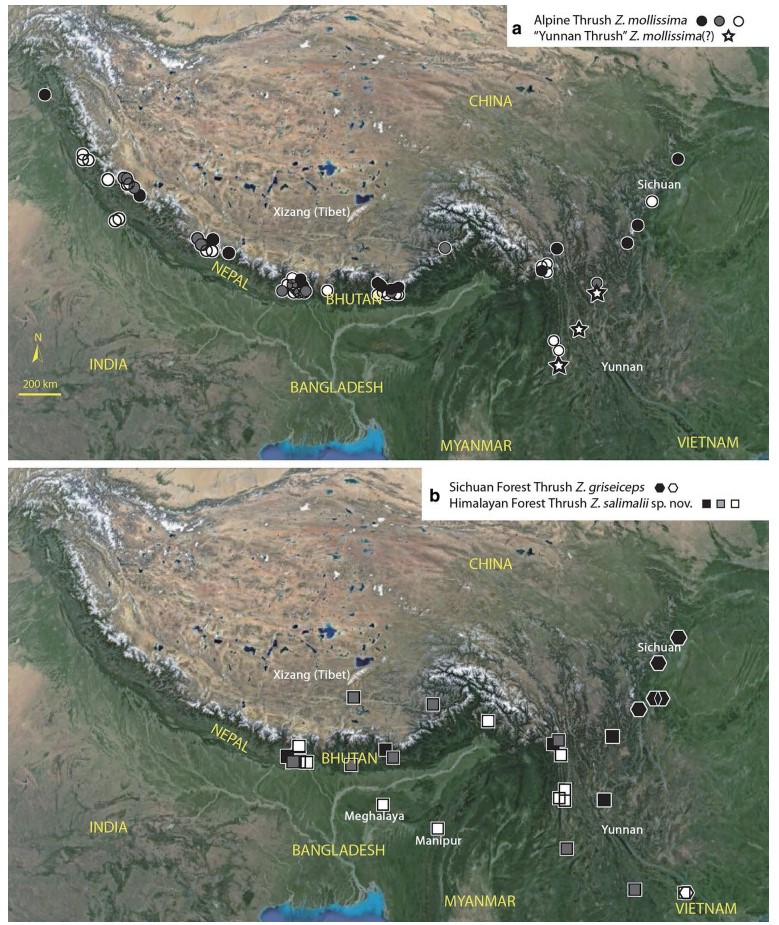
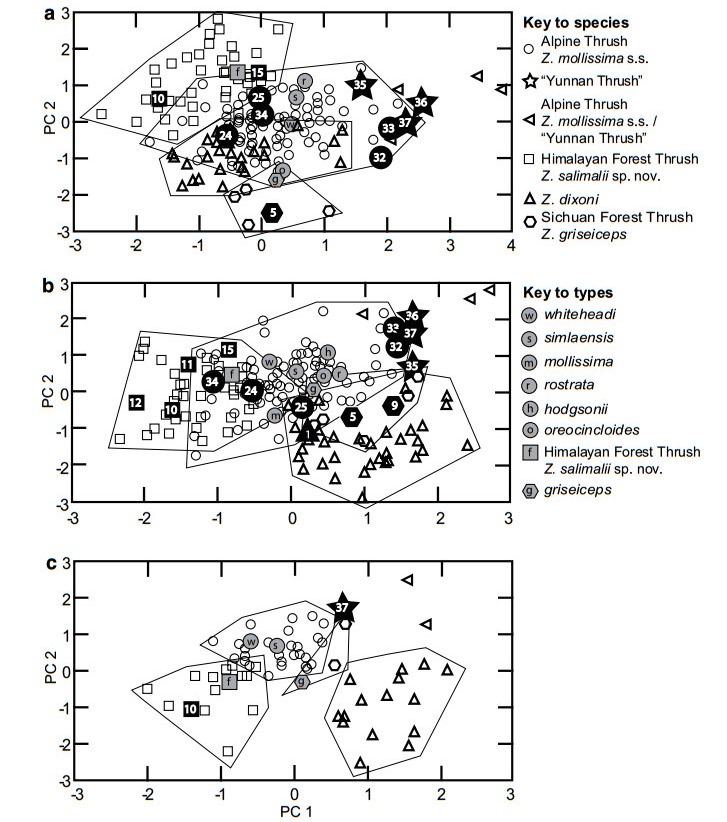
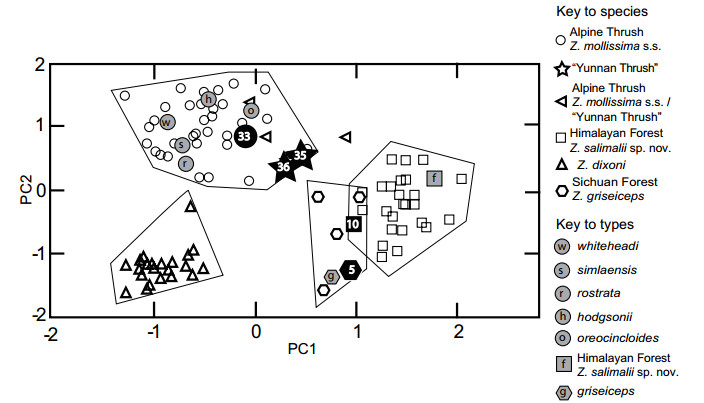
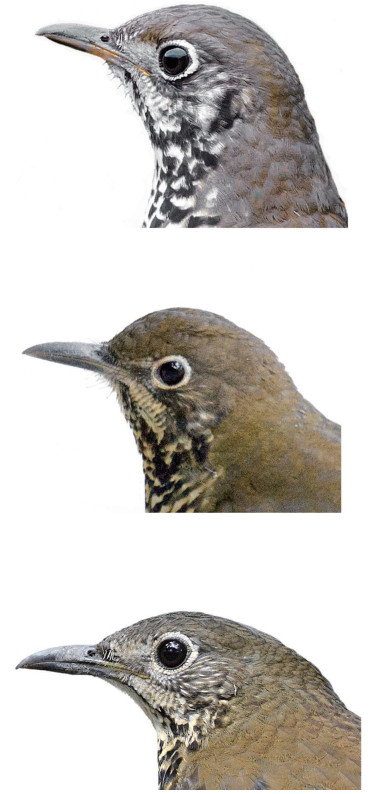
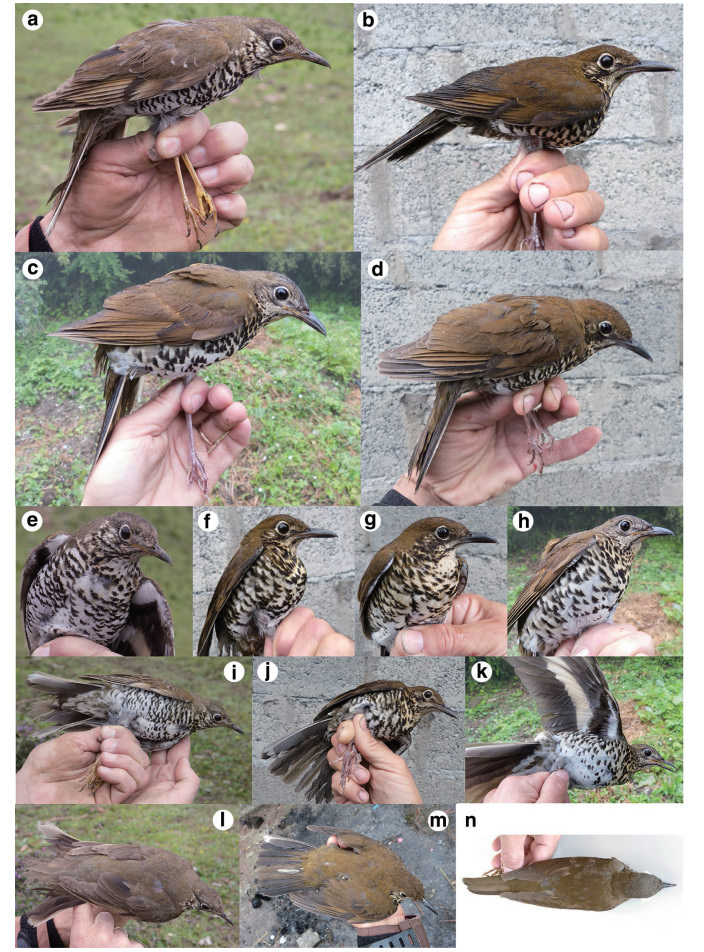

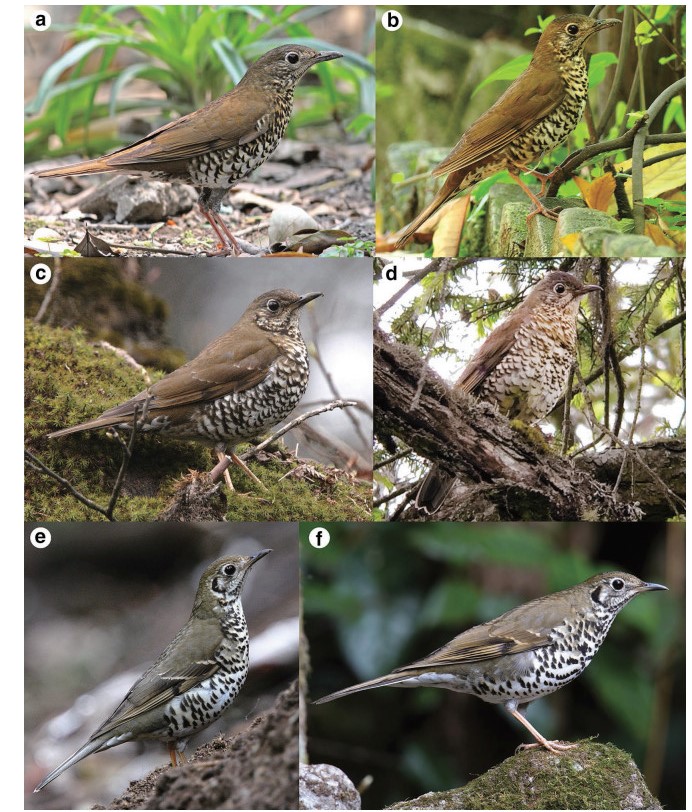
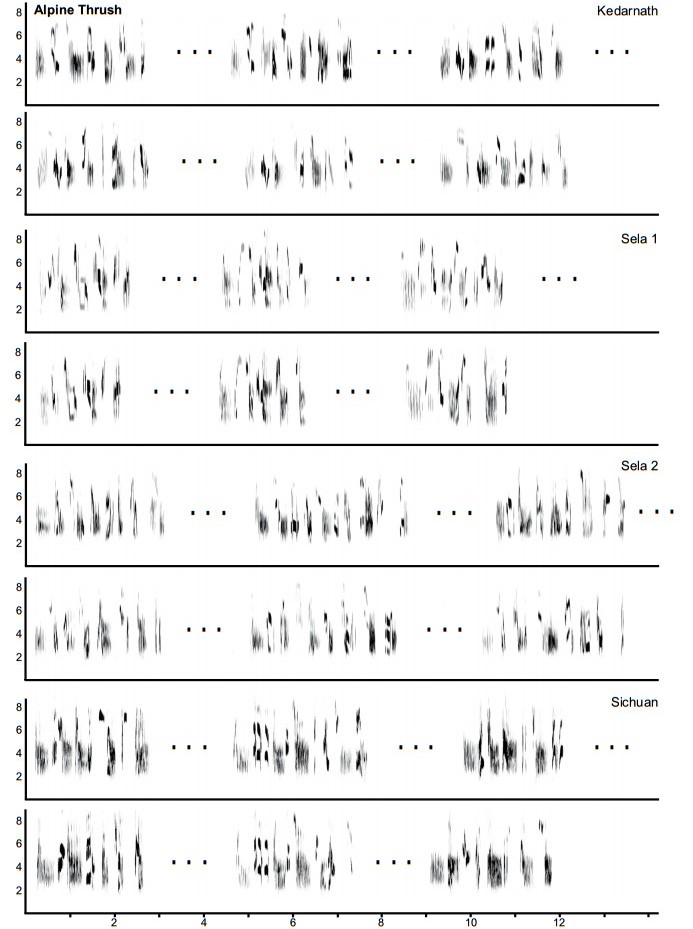
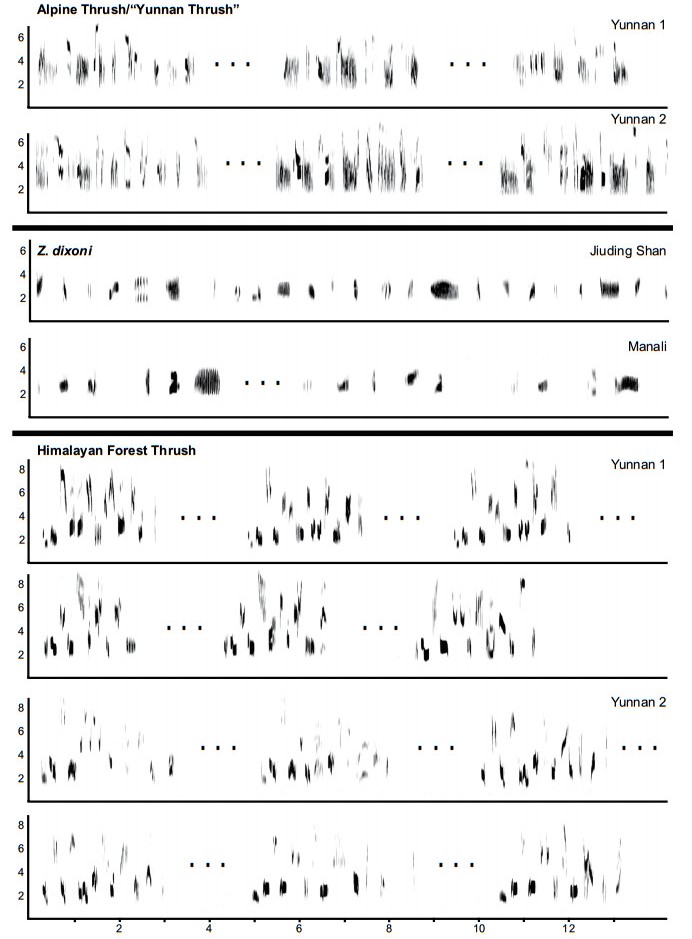
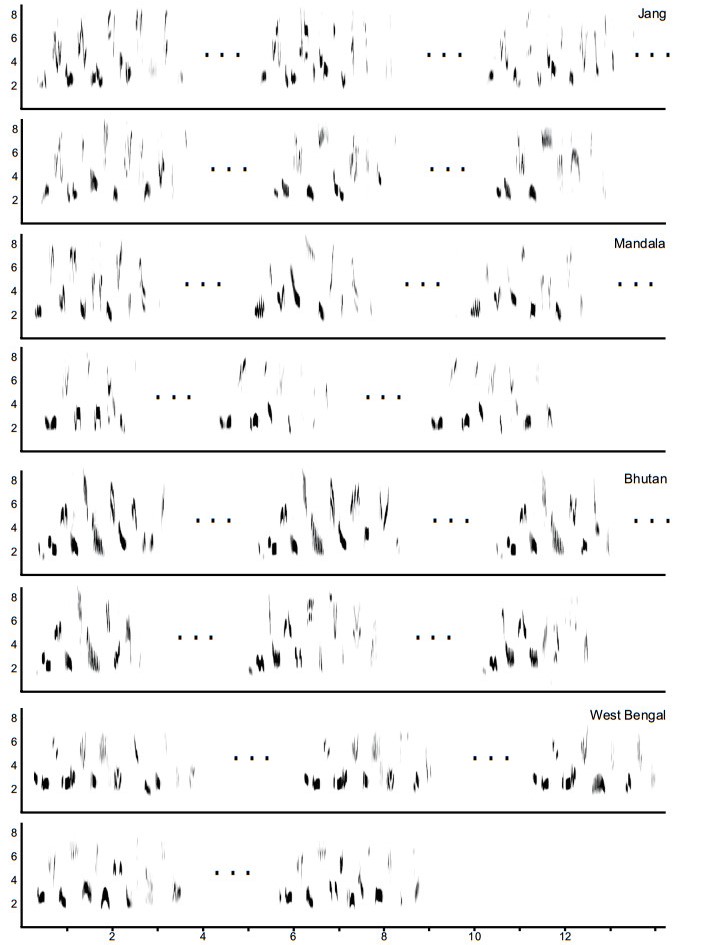
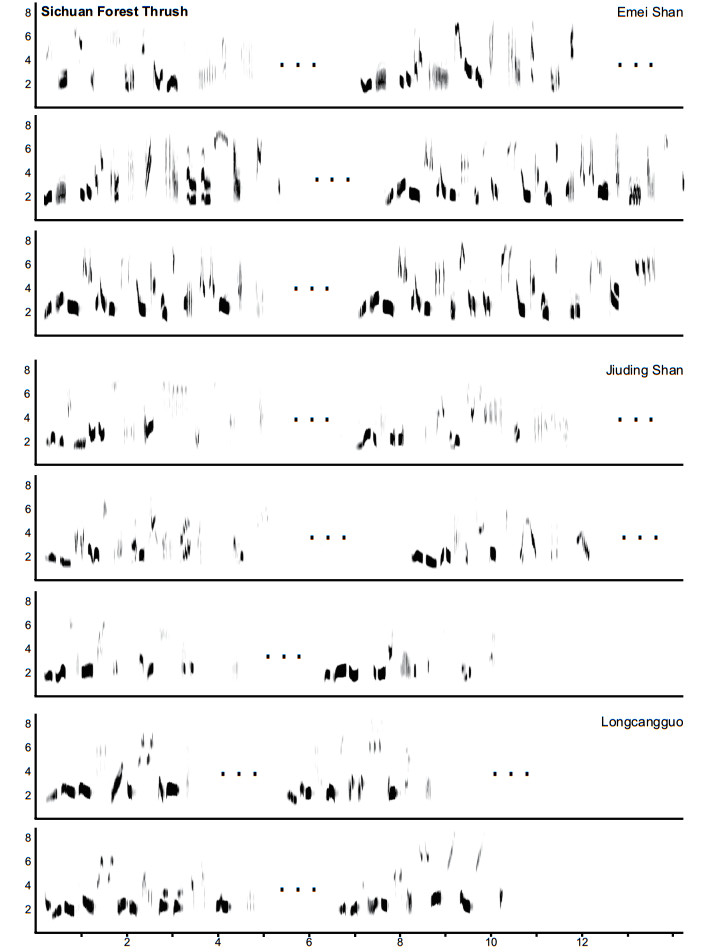
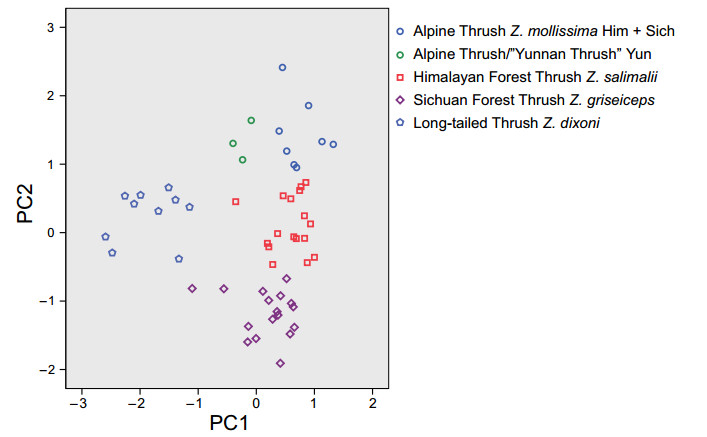
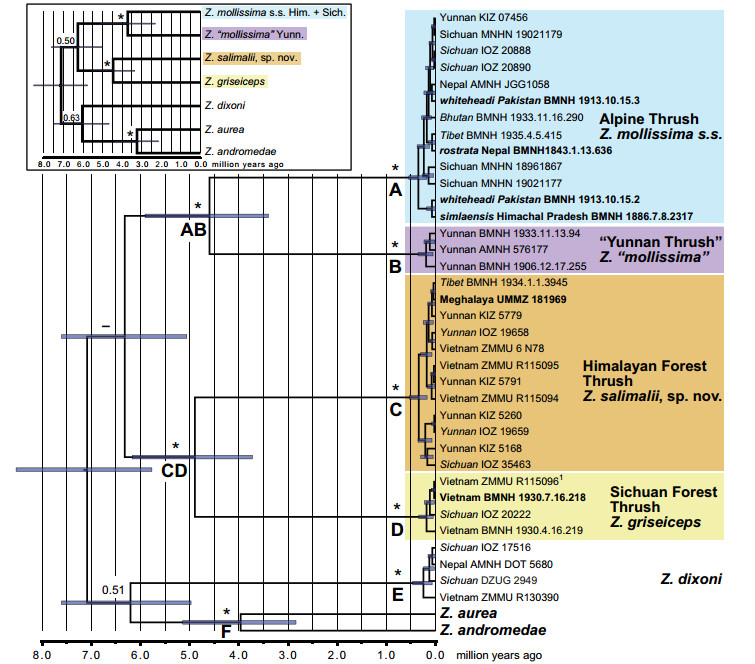
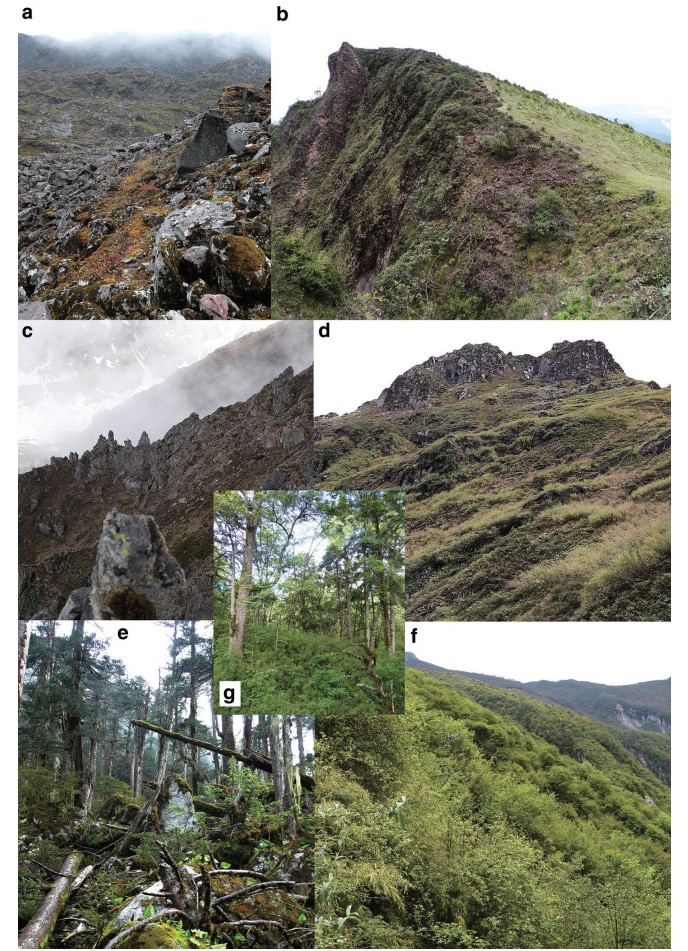





 Email Alerts
Email Alerts RSS Feeds
RSS Feeds